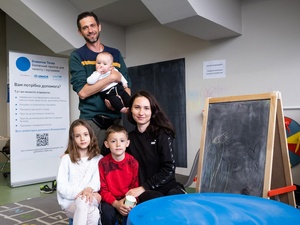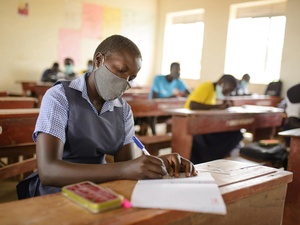Photo exhibition of Darfur's forsaken children opens in Madrid
Photo exhibition of Darfur's forsaken children opens in Madrid

A refugee girl from Darfur embodies the human drama of the conflict in western Sudan.
MADRID, Spain, Sept 2 (UNHCR) - The young girl gazes into the distance, seemingly oblivious to the camera that captures the fear on her face. Although we will never know the details of the horrors she has experienced, her expression tells us the centuries-old story of violence, pain and loss that children suffer in war.
The 14-year-old girl is one of the victims of the latest humanitarian crisis that is unfolding in Africa. She told of how she fled her village in Darfur, western Sudan, when it was attacked by Janjaweed militiamen on horse back. She walked many nights, alone, each step taking her further away from all that she has known. She crossed the border into Bahai, eastern Chad, in search of safety.
The reflection of sorrow and trauma on the girl's face was captured by Spanish photographer Álvaro Ybarra Zavala, who was in Chad and Darfur in July to cover the emergency for one of Spain's national newspapers.
"When I took that picture in the pouring rain in Bahai, I thought, what would have become of these people if UNHCR had not been there? We would have been talking about 200,000 dead instead of 200,000 refugees," said Zavala, giving his estimate of the number of Sudanese refugees in eastern Chad.
Backed by the Vocento media group, the photographer works with international organisations like UNHCR and Médecins Sans Frontières to shed light on invisible emergencies. In the recent past, he has worked with UNHCR on the forgotten drama of displaced indigenous people in Colombia.
Upon his return from Darfur, Zavala selected 53 photographs and together with UNHCR and its Spanish National Committee, turned them into an exhibition in Madrid titled "The forsaken children of Sudan".
The exhibition portrays the Darfur drama through its people - the child soldiers, the empty villages, the displaced people and the refugees. It is divided into four sections, showing the conflict, population displacement, humanitarian assistance in the refugee camps and the human tragedy of the old and sick in the refugee camps who have lost the strength to survive.
This exhibition, according to Zavala, "is the testimony of 200,000 people who want to be heard by the world; who are begging the world not to abandon them."
He will officially open "The forsaken children of Sudan" at the Centro Comercial Sexta Avenida in Madrid today. The exhibition will run until September 19, and feature two roundtable discussions on the situation in Darfur.
On September 9, Esteban Beltrán, the Director of the Spanish branch of Amnesty International, and Javier Fernández Arriba, Deputy Director of COLPISA news agency, will look into the details and impact of Amnesty International's report, "Darfur: Rape as a weapon of war".
On September 10, Oscar Mateo, Researcher of the Escola de Cultura de Pau in Barcelona, and Alberto Sotillo, Foreign Correspondent of the newspaper ABC, will examine what happens to early warning systems in the wake of crises in the former Yugoslavia and Africa's Great Lakes region. Both roundtable debates will be moderated by UNHCR's Representative in Spain, Carlos Boggio.









